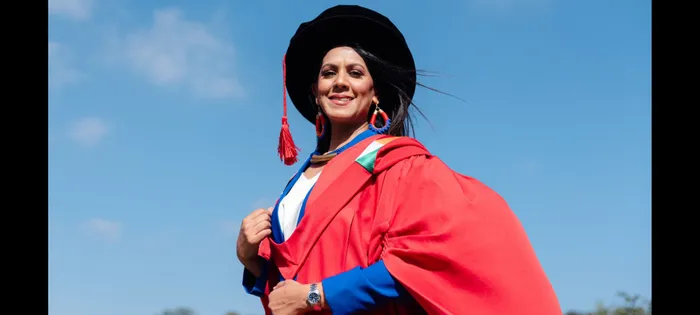PhD graduate from UKZN highlights bullying as a societal issue

Ms Suhana Jacobs, a PhD graduate from UKZN, highlights bullying and how it has become a societal issue Picture: UKZN

Bullying in both physical and cyber spaces is a concerning society issues, says PhD graduate, Suhana Jacobs, who was driven to investigate the complex problem in the digital age. Ms Jacobs graduated from the University of KwaZulu-Natal (UKZN) Spring graduation ceremony this week.
She said in recent years, videos depicting violence and harassment among school learners have been steadily on the increase.
“The explosion of disturbing videos posted on social media of assaults and harassment among school learners provoked my academic interest in the phenomenon of school violence and its somewhat unexplored relationship with the virtual schoolyard within the context of cyberbullying,” said Ms Jacobs. “This mirrors what is happening with young people. It gives us a disturbing view of society. It prompts the need for greater insights into why young people create, circulate and forward embarrassing content of their peers — content that deliberately harasses, humiliates and injures,”
She added that the goal of this action research study was to explore the experiences of young adult survivors who have endured both physical and cyber bullying and their responses to it. Ms Jacobs said a surprising discovery for her that emerged through the study is the original conceptualisation of “extended bullying.” Her research revealed that, rather than existing in isolation, bullying unfolds across four interlocking dimensions: participant extension, content extension, spatial extension, and temporal extension. The exploration of these extensions reveals startling awareness of just how pervasive the phenomenon is and how the psycho-social impacts are fully recognised and understood when the phenomenon of bullying is viewed through the prism of multi-dimensional extension, she said.
“Once an incident of bullying captured on video is uploaded and shared digitally, it can expand its reach exponentially,” said Ms Jacobs. “Anyone connected to the digital environment can share the content to multiple online locations and audiences. These audiences are then active or passive participants, simply by consuming content. As the views increase — itself an impetus for further audience interest and increased rankings on social media - the content thereby continues being shared and shaped by participants.”
The study of the psycho-social impacts of bullying revealed disturbing insights, she added. Relaying their experiences, survivors shared how the impact of the bullying practices worsens their suffering and causes lasting, damaging impact. Psycho-social impacts include increased pain, negative self-image, a damaged sense of identity, heightened fear, overwhelming loneliness and feelings of dehumanisation.
Hearing the testimonies of the survivors, Ms Jacobs realised that the click of a button is all it takes to change someone’s life drastically.
“In the instant that the video clip or image is uploaded to social media, it takes on an entirely new life. The lives of young people are substantially entwined with digital media technology, with access to such media and devices growing rapidly. This rise in connectivity and access to social media platforms has raised critical issues relating to safety, privacy, and abuse. For a long time, school violence was primarily located in the physical realm. However, technology has blurred the boundaries of physical space with the introduction of cyberspace. One of the areas requiring urgent scholarship and intervention within the broader context of school violence is that of the filming of such incidents of physical bullying and posting such recordings on social media,” she said.
To address the issue, Ms Jacobs hosted collaborative workshops through partnerships with survivors, youth, and teachers. Her aim was to foster empathy, critical thinking, collaboration, problem-solving, and dialogue among learners and educators. This approach provided evidence and creativity for the development of an educational resource as an intervention for addressing extended bullying in schools.
Prof Vaughn John, Ms Jacobs supervisor and acting Dean and Head of the School of Education, congratulated Ms Jacobs on her comprehensive study.
“This study involved broad and deep engagement with survivors of bullying, youth, and educators; with their insights and experiences enriching the research design,” said Prof John. “This collaborative approach ensured that the voices of those most affected by bullying were recognised and harnessed towards finding solutions.”